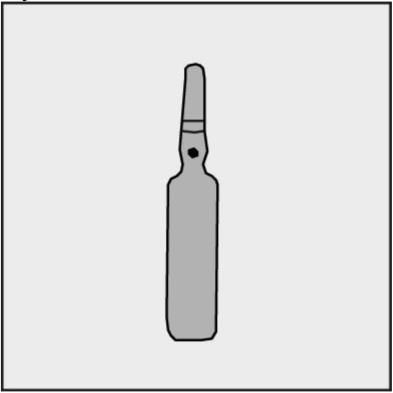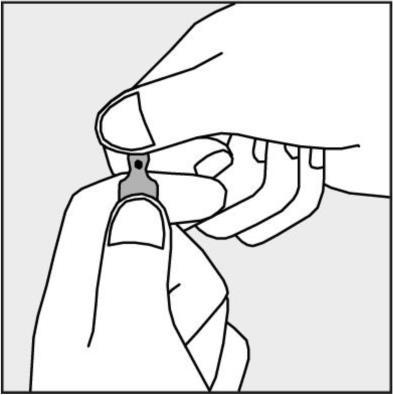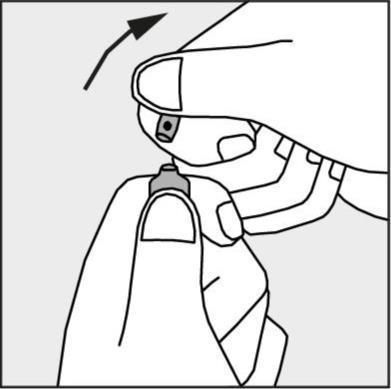

Naloxonum hidrohloricum Vzf

Ask a doctor about a prescription for Naloxonum hidrohloricum Vzf

How to use Naloxonum hidrohloricum Vzf
Leaflet attached to the packaging: patient information
Warning! The leaflet should be kept. Information on the immediate packaging in a foreign language.
NALOXONUM HYDROCHLORICUM WZF
400 micrograms/ml, solution for injection
Naloxone hydrochloride
The leaflet should be read carefully before taking the medicine, as it contains important information for the patient.
- The leaflet should be kept so that it can be read again if necessary.
- In case of any doubts, the patient should consult a doctor, pharmacist, or nurse.
- This medicine has been prescribed to a specific person. It should not be given to others. The medicine may harm another person, even if the symptoms of their illness are the same.
- If the patient experiences any side effects, including any side effects not listed in this leaflet, they should inform their doctor, pharmacist, or nurse. See section 4.
Table of contents of the leaflet
- 1. What is Naloxonum hydrochloricum WZF and what is it used for
- 2. Important information before taking Naloxonum hydrochloricum WZF
- 3. How to take Naloxonum hydrochloricum WZF
- 4. Possible side effects
- 5. How to store Naloxonum hydrochloricum WZF
- 6. Contents of the packaging and other information
1. What is Naloxonum hydrochloricum WZF and what is it used for
Naloxonum hydrochloricum WZF contains the active substance naloxone and belongs to a group of medicines called opioid antagonists.
Naloxonum hydrochloricum WZF reverses (blocks) the unwanted effects of strong painkillers - opioids (e.g., morphine), such as breathing difficulties and drowsiness.
Naloxonum hydrochloricum WZF is used:
- in case of an overdose of strong painkillers (opioids) and severe breathing difficulties;
- to reverse the effect of opioids used during surgery;
- to treat breathing difficulties in newborns whose mothers received opioids during delivery;
- to determine if the cause of poisoning is opioids.
Naloxonum hydrochloricum WZF is always administered by medical personnel.
2. Important information before taking Naloxonum hydrochloricum WZF
When not to take Naloxonum hydrochloricum WZF:
- if the patient is allergic to naloxone or any of the other ingredients of this medicine (listed in section 6).
Warnings and precautions
Before starting treatment with Naloxonum hydrochloricum WZF, the patient should discuss it with their doctor or pharmacist.
The doctor will exercise particular caution when administering Naloxonum hydrochloricum WZF and will take appropriate action:
- if the patient has taken too much opioid or is addicted to opioids, acute withdrawal syndrome may develop, with symptoms such as high blood pressure, rapid heartbeat, severe breathing difficulties, or cardiac arrest, which can sometimes be fatal;
- if withdrawal symptoms occur, such as nausea, vomiting, diarrhea, weakness, rapid heartbeat, increased blood pressure, fever, runny nose, sneezing, piloerection (so-called "goosebumps"), sweating, yawning, nervousness, anxiety, irritability, tremors, abdominal cramps, pain in various parts of the body; in newborns, seizures, excessive crying, and increased reflexes may occur;
- if Naloxonum hydrochloricum WZF is to be administered to a newborn whose mother took opioids before delivery or is addicted to opioids, as severe withdrawal symptoms may occur in the newborn;
- if the patient has heart disease or cardiovascular disease, or is taking heart medications, or medications with adverse effects on the cardiovascular system, as these patients are at higher risk of adverse effects, such as irregular heartbeat, high or low blood pressure, or breathing difficulties;
- if the patient has taken a strong painkiller - buprenorphine or pentazocine, as the effectiveness of Naloxonum hydrochloricum WZF is limited in this case;
- if breathing difficulties occur after administration of Naloxonum hydrochloricum WZF, as this may be due to the shorter duration of action of naloxone compared to opioids;
- if Naloxonum hydrochloricum WZF is administered after surgery, during which opioids were used, as symptoms such as nausea, vomiting, tremors, high blood pressure, and rapid heartbeat may occur (see section 4);
- if the patient has liver or kidney disease.
Naloxonum hydrochloricum WZF and other medicines
The patient should tell their doctor about all medicines they are currently taking or have recently taken, as well as any medicines they plan to take.
The patient should inform their doctor if they have taken or are taking:
- strong painkillers (e.g., morphine, codeine, buprenorphine, pentazocine);
- sleeping pills and/or sedatives;
- medicines that may affect the heart or cardiovascular system (e.g., medicines used to treat high blood pressure, tricyclic antidepressants, calcium antagonists, beta-adrenergic blockers, digoxin, clonidine, cocaine, methamphetamine). Severe high blood pressure has been reported during the administration of naloxone hydrochloride in cases of clonidine-induced coma.
Pregnancy and breastfeeding
If the patient is pregnant or breastfeeding, thinks they may be pregnant, or plans to have a child, they should consult their doctor before taking this medicine.
The patient should tell their doctor if they:
- are pregnant;
- think they may be pregnant;
- plan to become pregnant;
- are breastfeeding. The decision to use Naloxonum hydrochloricum WZF during pregnancy or breastfeeding is made by the doctor.
Naloxonum hydrochloricum WZF may cause withdrawal symptoms in newborns (see information above).
Naloxone may be used in pregnant women only when, in the doctor's opinion, its use is absolutely necessary. Breastfeeding should be avoided for 24 hours after administration of the medicine.
Driving and operating machinery
The patient should not drive or operate machinery for at least 24 hours after taking the medicine.
Naloxonum hydrochloricum WZF contains sodium
The medicine contains 3.36 mg of sodium (the main component of common salt) per 1 ml of solution. This corresponds to 0.17% of the maximum recommended daily intake of sodium in the diet for adults.
The medicine contains 84 mg of sodium (the main component of common salt) in the maximum daily dose of 10 mg of naloxone (25 ml of solution). This corresponds to 4.2% of the maximum recommended daily intake of sodium in the diet for adults.
The medicine can be diluted - see below "Information intended exclusively for healthcare professionals". When calculating the total sodium content in the prepared, diluted solution, the sodium content from the diluent should be taken into account. To obtain accurate information about the sodium content in the diluent, the patient should consult the product characteristics of the medicinal product used as the diluent.
3. How to take Naloxonum hydrochloricum WZF
Naloxonum hydrochloricum WZF is always administered by medical personnel.
The medicine can be administered:
- intravenously - injected directly into a vein or administered in a drip;
- intramuscularly;
- subcutaneously. The dose of the medicine is determined by the doctor. The administered dose depends on the patient's weight, condition, and the type and amount of opioid used.
Administration of a higher dose of Naloxonum hydrochloricum WZF than recommended
- After administration of higher doses of naloxone, pain and muscle tension may recur.
- The medicine is administered by medical personnel, so it is unlikely that the patient will receive more medicine than they should.
4. Possible side effects
Like all medicines, Naloxonum hydrochloricum WZF can cause side effects, although not everyone will experience them.
All medicines can cause allergic reactions, but severe allergic reactions after taking this medicine are very rare. If the patient experiences wheezing, breathing difficulties, swelling of the eyelids, face, or lips, rash, or itching (especially affecting the whole body), they should see a doctor immediately.
The following side effects have been reported:
- Very common (occurring in more than 1 in 10 patients):
- nausea.
Common (occurring in less than 1 in 10 patients):
- dizziness;
- headache;
- rapid heartbeat;
- low or high blood pressure;
- vomiting;
- postoperative pain.
Uncommon (occurring in less than 1 in 100 patients):
- tremors, sweating;
- heart rhythm disturbances, slow heartbeat;
- diarrhea;
- dry mouth;
- irritation of the blood vessel walls after intravenous administration of the medicine;
- local irritation, burning, and redness at the site of intramuscular administration of the medicine;
- rapid and deep breathing.
Rare (occurring in less than 1 in 1,000 patients):
- seizures;
- muscle tension.
Very rare (occurring in less than 1 in 10,000 patients):
- severe heart disorders (ventricular fibrillation, cardiac arrest);
- pulmonary edema (symptoms include fluid in the lungs, breathing difficulties, apnea);
- erythema multiforme (symptoms include widespread skin changes, skin discoloration, and mucous membrane damage);
- allergic reactions (symptoms include hives, rhinitis, dyspnea, facial edema), anaphylactic shock (severe allergic reaction).
Reporting side effects
If the patient experiences any side effects, including any side effects not listed in the leaflet, they should inform their doctor, pharmacist, or nurse. Side effects can be reported directly to the Department of Monitoring of Adverse Reactions to Medicinal Products of the Office for Registration of Medicinal Products, Medical Devices, and Biocidal Products
Al. Jerozolimskie 181C
02-222 Warsaw
Phone: +48 22 49 21 301
Fax: +48 22 49 21 309
Website: https://smz.ezdrowie.gov.pl
Reporting side effects can help gather more information on the safety of the medicine.
5. How to store Naloxonum hydrochloricum WZF
The medicine should be stored out of sight and reach of children.
Store in a temperature below 25°C. Store in the original packaging to protect from light.
Do not use this medicine after the expiry date stated on the packaging. The expiry date refers to the last day of the month.
Medicines should not be disposed of via wastewater or household waste. The patient should ask their pharmacist how to dispose of medicines that are no longer needed. This will help protect the environment.
6. Contents of the packaging and other information
What Naloxonum hydrochloricum WZF contains
- The active substance of the medicine is naloxone hydrochloride. Each 1 ml of solution contains 400 micrograms of naloxone hydrochloride (in the form of naloxone hydrochloride dihydrate).
- The other ingredients are: sodium chloride, diluted hydrochloric acid (to adjust pH), water for injections.
What Naloxonum hydrochloricum WZF looks like and what the packaging contains
Naloxonum hydrochloricum WZF is a colorless, clear solution for injection.
Ampoules made of colorless glass containing 1 ml of solution are packed in a cardboard box.
The cardboard box contains 10 ampoules.
For more detailed information, the patient should contact the marketing authorization holder or the parallel importer.
Marketing authorization holder in Bulgaria, the country of export:
Warsaw Pharmaceutical Works Polfa S.A.
ul. Karolkowa 22/24, 01-207 Warsaw
Poland
Manufacturer:
Warsaw Pharmaceutical Works Polfa S.A.
ul. Karolkowa 22/24, 01-207 Warsaw
Poland
Parallel importer:
Delfarma Sp. z o.o.
ul. Św. Teresy od Dzieciątka Jezus 111
91-222 Łódź
Repackaged by:
Delfarma Sp. z o.o.
ul. Św. Teresy od Dzieciątka Jezus 111
91-222 Łódź
Number of the permit in Bulgaria, the country of export: 20030166
Number of the permit for parallel import: 39/22 Date of approval of the leaflet: 18.01.2022
[Information about the trademark]
Information intended exclusively for healthcare professionals
NALOXONUM HYDROCHLORICUM WZF
400 micrograms/ml, solution for injection
Naloxone hydrochloride
Method of administration of Naloxonum hydrochloricum WZF
The medicine is administered intravenously, intramuscularly, or subcutaneously, or as an intravenous infusion after prior dilution.
In the case of intravenous infusion, the solution should be diluted with sodium chloride 0.9% or glucose 5% solution as follows: 2000 micrograms (5 ml of solution containing 400 micrograms/ml of naloxone) in 500 ml of diluent. The resulting solution after dilution contains 4 micrograms of naloxone per 1 ml. The solution should be prepared immediately before administration.
Note: Naloxonum hydrochloricum WZF should not be administered in the same intravenous infusion as other medicines.
During administration of the medicine, the possibility of oxygen therapy and resuscitation treatment, as well as access to equipment enabling cardiopulmonary resuscitation, should be ensured.
Instructions for opening the ampoule
Before opening the ampoule, the patient should make sure that the entire solution is in the lower part of the ampoule.
The ampoule can be gently shaken or tapped with a finger to facilitate the flow of the solution.
A white dot (see Figure 1) is placed on each ampoule as a mark indicating the location of the break point below it.
- To open the ampoule, it should be held vertically in both hands, with the white dot facing each other - see Figure 2. The upper part of the ampoule should be grasped in such a way that the thumb is above the white dot.
- Press according to the arrow shown in Figure 3. The ampoules are intended for single use only and should be opened immediately before use. The remaining contents of the unused medicine should be destroyed in accordance with applicable regulations.
Figure 1.

Figure 2.

Figure 3.

Dosing of Naloxonum hydrochloricum WZF
The dose of naloxone and the route of administration depend on the patient's condition, the type of opioid used, and its amount.
Opioid overdose
Adults
Usually, an initial single dose of 400 to 2000 micrograms is administered intravenously.
If necessary, the intravenous dose can be repeated every 2-3 minutes until the patient regains consciousness and has a regular, measured breathing pattern. If there is no improvement in respiratory function and no return of consciousness after administration of 10 mg, the cause of these symptoms is probably not an opioid overdose.
The medicine can also be administered intramuscularly or subcutaneously. In life-threatening situations, the medicine should be administered intravenously.
Children
Usually, the initial single dose administered intravenously is 10 micrograms per kilogram of body weight. If necessary, an additional dose of 100 micrograms per kilogram of body weight can be administered.
If it is not possible to administer naloxone intravenously, the medicine should be used intramuscularly or subcutaneously in divided doses.
Reversal of opioid-induced anesthesia
Adults
Usually, 100 micrograms to 200 micrograms are administered intravenously, i.e., 1.5-3 micrograms per kilogram of body weight.
In some cases, especially when a long-acting opioid has been used, it may be necessary to administer an additional dose of naloxone intramuscularly within 1-2 hours. The medicine can also be administered as an intravenous infusion.
Children
Intravenously, 10 micrograms per kilogram of body weight. If necessary, an additional dose of 100 micrograms per kilogram of body weight can be administered.
If it is not possible to administer naloxone intravenously, the medicine should be used intramuscularly or subcutaneously in divided doses. The medicine can also be administered as an intravenous infusion.
Reversal of respiratory depression in newborns caused by administration of opioids to the mother during delivery
Newborns
In case of apnea, it should be ensured that the airway is maintained before administering the medicine.
Intravenously, intramuscularly, or subcutaneously, 10 micrograms per kilogram of body weight. If necessary, the dose can be repeated after 2-3 minutes.
It is also possible to administer a single dose of naloxone intramuscularly, 200 micrograms (i.e., approximately 60 micrograms per kilogram of body weight).
Differential diagnosis of opioid overdose
Intravenous administration of a dose of 0.5 micrograms per kilogram of body weight of naloxone allows determination of whether respiratory depression or urinary retention is not caused by an opioid. Then, the dose of naloxone can be gradually increased, avoiding too high doses. High doses eliminate all effects of opioids, including analgesic effects, and also cause stimulation of the sympathetic nervous system and cardiovascular system.
- Country of registration
- Active substance
- Prescription requiredNo
- Marketing authorisation holder (MAH)Warszawskie Zakłady Farmaceutyczne POLFA S.A.
- This information is for reference only and does not constitute medical advice. Always consult a licensed doctor before taking any medication. Oladoctor is not responsible for medical decisions based on this content.
- Alternatives to Naloxonum hidrohloricum Vzf
Alternatives to Naloxonum hidrohloricum Vzf in other countries
The best alternatives with the same active ingredient and therapeutic effect.
Alternative to Naloxonum hidrohloricum Vzf in Spain
Alternative to Naloxonum hidrohloricum Vzf in Ukraine
Online doctors for Naloxonum hidrohloricum Vzf
Discuss dosage, side effects, interactions, contraindications, and prescription renewal for Naloxonum hidrohloricum Vzf – subject to medical assessment and local rules.






